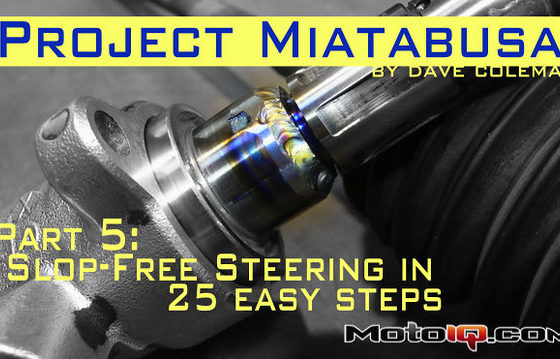Wrench Tips #22
Making a Clean Splice
by Dave Coleman
Splicing two wires together is the most basic of wiring tasks, and yet most people seem to do a crappy job of it. Those standard insulated butt connectors are crap. They’re bulky, offer no strain relief to deal with bending and vibration, and it’s hard to tell when they’re crimped enough not to fall out.
Wiring harness problems in a production car can be so heinously difficult to diagnose that one bad splice could easily mean the manufacturer would have to buy the car back as a lemon. When harness quality is that important, you can be damn sure whatever you find in an OE harness is a good idea.

Take apart a few factory harnesses, whether they’re Nissan, Mazda or Suzuki (all which I’ve been unwrapping lately), and you’ll find these same simple crimp connectors wherever wires are spliced together. Nissan (at least in the ’90s) took the extra step of dousing the splice in tar-like goo, while the others just wrapped the splice tightly in electrical tape before wrapping the whole harness.
Sadly, I can’t find these simple, compact splices anywhere, so I’ve had to resort to a variety of slightly different techniques.
Waytek does sell something reasonably similar to the OE splices, which I’ll probably try next time. You can find them here.

 Most of the time, I’ll use one of these non-insulated butt connectors. The shorter connectors above require you to control both wires and the connector while you’re crimping, while the longer ones let you crimp one wire at a time. On the other hand, the longer connector is, well, longer. which can sometimes make the harness a little stiffer and bulkier.
Most of the time, I’ll use one of these non-insulated butt connectors. The shorter connectors above require you to control both wires and the connector while you’re crimping, while the longer ones let you crimp one wire at a time. On the other hand, the longer connector is, well, longer. which can sometimes make the harness a little stiffer and bulkier.
Insulating either one with with heat shrink turns it into a well sealed connection, and the heat shrink acts as a strain relief, helping to prevent pullout or fatigue. If you’ve ever taken apart a 40-year old Datsun harness, you’ll be pretty serious about keeping moisture out of your splices. Corroded wires can be a real bummer.
Speaking of sealing, the baller way to make sure your crimps are sealed is to use adhesive-lined heat shrink tubing. This stuff is expensive though. Typically, I’ll use cheap, Chinese heat shrink, and just paint the connector with liquid electrical tape before shrinking. Less pretty, just as effective, and about 1/10 the cost.

When you need speed and quality more than cheapness, these all-in-one crimp/solder/heat shrink connectors are DEEluxe. Note how the two splices are staggered here. This practice helps keep the finished harness from getting bulky in areas with lots of splices.

After crimping, just hit these connectors with a manly heat gun and the low-temperature solder inside will do its thing while the adhesive-lined heat shrink seals things up. There’s a little bit of an art to removing the heat before the heat shrink splits, and before the liquid solder shoots out the end of the heat shrink, but with a little practice, these are fast and really high quality splices.

Finally, if I’m out of crimp connectors, or I just need the splices to be as small-diameter as possible, I’ll resort to soldering. When soldering two wires that have to live in a harness in a moving car, I’ll always make sure the wires have a strong mechanical connection like this. You never know how much tension might be on an individual wire inside a harness once it’s wrapped and installed.

Then, when soldering, I’ll hit it fast, with a really hot soldering iron. You can achieve the same result more slowly with a less-hot iron, but this gives the heat more time to travel up the wire, where it can damage insulation and, worse, accidentally shrink the heat-shrink tubing you have waiting to cover this splice. That’s a serious bummer.





1 comment
It took me 10 years to find a source for the U-crimps, but I finally did:
http://www.cycleterminal.com/splice-terminals.html